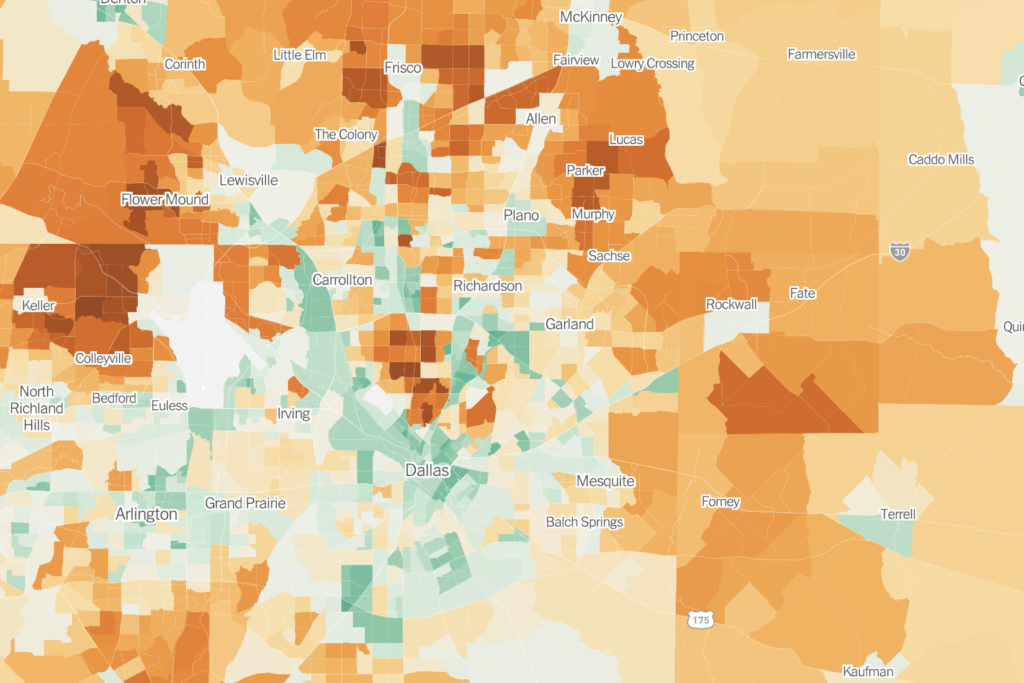The New York Times published an interactive map this week that seeks to understand the climate impact of households in metro areas across the country. What it found is fascinating, if not something we knew anecdotally: denser neighborhoods that feature a mix of housing, services, jobs, and retail tend to generate less greenhouse gases than suburbs and neighborhoods far from those things. It also shows that wealthier people account for a larger carbon footprint because of their consumption and travel patterns.
The data come courtesy the CoolClimate Network at the University of California at Berkeley and its partner, the consulting firm EcoDataLab. Researchers spent over a decade conducting a “consumption-based analysis” that helped the university map the entire country’s household emissions.
It’s an environmental argument for policies that encourage density, allowing more people to live near where they work, shop, worship, and go out. Chris Jones, the director of the CoolClimate Network, has hopes for the data:
Cities and local governments could use the data to identify the most effective ways to fight climate change — by, for example, encouraging developers to build more housing in neighborhoods where people don’t need cars to get around or helping households in suburbs more quickly adopt cleaner electric vehicles.
The lowest greenhouse gas contributions in Dallas come in South Dallas, downtown, Uptown, West Dallas, and portions of Oak Cliff. The highest contributors are in the Park Cities, Preston Hollow, and much of North Dallas. The center of the suburbs actually fare well. Plano is below the national average of 41 tons of CO2 emitted per household, as are portions of Richardson, Frisco, and Allen. But the farther east and west you go, the higher the emissions.
Which is difficult news considering all the new homes going up in greenfield subdivisions in our suburbs and exurbs. Here’s the Times again:
Those high-emissions communities are in part the result of government investment in roads and highways in the postwar era. Add to that white flight from cities, as well as the simple fact that many Americans increasingly wanted, and could afford, the quintessential single-family home with a yard and a driveway in the suburbs. While the pace of suburban sprawl slowed in the early 2010s as interest in city living rebounded, it has more recently picked up again in the wake of the pandemic as remote work allows people to live farther from job centers.
Dallas policymakers should see an opportunity here. The findings show how land use informs emissions. And the city just so happens to be rewriting its policy that dictates what can be built and where. It’s also in the midst of implementing its Comprehensive Environmental and Climate Action Plan, or CECAP, which has a goal to make the city carbon-neutral by 2050. The Times data could hint at ways to accelerate that timeline. If density is one of those accelerants, there are plenty of opportunities.
Earlier this year, the nonprofit Child Poverty Action Lab found that 48 percent of Dallas is zoned for single-family homes with detached garages. Another 17 percent of our land mass is tied up in planned development districts, which are carveouts for developers who asked the City Council for permission to do something that the code wouldn’t allow.
Which, for our purposes, means it’s tricky to know what is allowed in those 65 square miles. We also have research from 2019 that identified just 38 walkable communities in all of North Texas. Those account for just .12 percent of the region’s land mass. A big reason for that is suburban sprawl.
The Times cites an estimate that the United States needs to add up to 20 million new homes to meet demand. Putting those in “climate-friendly neighborhoods” could lower carbon dioxide emissions by 200 million tons each year by 2030, which would be like yanking 43 million cars out of traffic.
And here’s the other interesting part: this isn’t telling cities to put a skyscraper in Lower Greenville. It’s about the small-scale adjustments that help improve the quality of life closer to where you live. Adjusting policies—like not requiring a certain amount of parking spots—to encourage stores and restaurants to open closer to neighborhoods, giving residents an option that might not require a car trip.
Those tenets can be applied in the suburbs just as they can in Dallas’ urban neighborhoods. Back in 2018, we identified existing vacant buildings that were just waiting for development. The West Oak Cliff Area Plan, which will help dictate what rezoning allows, specifically highlighted a few of those, such as Pierce and Catherine streets, where an abandoned old strip mall sits next to single-family homes.
There is already a business argument for these types of developments. We know, because of research by George Washington University’s Center for Real Estate & Urban Analysis, that those 38 walkable neighborhoods accounted for 12 percent of the entire economic output of this region. Now the Times presents data that adds a climate benefit, too.
Author






